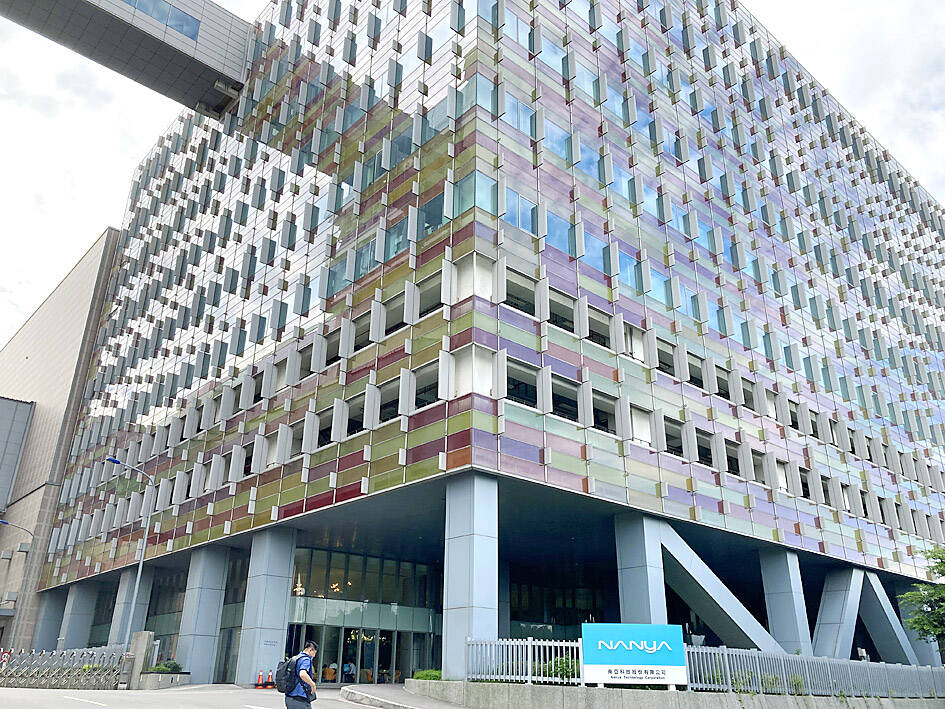Nanya Technology Corp (南亞科技) yesterday reported its biggest quarterly loss in about a year, but the DRAM chipmaker said it has seen nascent signs indicating that the slump is close to bottoming out as rising demand is propping up chip prices.
Nanya Technology expects an improvement in demand for advanced DDR5 memory chips driven by growing demand for artificial-intelligence (AI) computing for enterprise cloud centers.
The company expects to see a rebound in smartphone sales in China this quarter and better PC demand following the launch of new chips by Intel Corp, it said.

Photo: Lisa Wang, Taipei Times
Strong demand for Huawei Technologies Co’s (華為) new phones did not benefit Nanya Technology, as it was not granted a waiver from the US to resume supply of DDR4 and low-power DDR4 chips to Huawei, it said.
On the supply side, overall chip inventory is slimming down as the world’s major memorychip makers have maintained capacity after reducing it, Nanya Technology said.
Additionally, chipmakers are concentrating on shifting capacity to next-generation high-end DDR5 and high-band-memory (HBM) chips mostly used in servers, leading to a lower supply of mainstream DDR4 chips, it said.
“Nanya has a chance to shrink its losses this quarter, as end-product demand is improving. In addition, chip prices are more stable than in the third quarter,” company president Lee Pei-ing (李培瑛) told an online media briefing yesterday. “The prices of DDR5 have picked up. We expect a slight increase in DDR3 and DDR4 prices in the fourth quarter. We have seen some early signs.”
Nanya Technology primarily supplies DDR4, low-power DDR4 and DDR3 memory chips. The chipmaker expects to add its first DDR5 chip to its product lineup by the end of next year.
The New Taipei City-based memorychip maker plans to cut factory utilization by about 20 percent this quarter, extending its output control measures from the past few quarters. Like most major memory chipmakers, Nanya Technology said its inventory is thinning, but has not returned to healthy levels yet.
Shipments would rise moderately this quarter on a quarterly basis, following 10 percent growth last quarter, Lee said.
Losses widened to NT$2.51 billion (US$78.14 million) during the July-to-September period, compared with the losses of NT$771 million in the second quarter, the company’s financial statement showed.
That marked the fourth straight unprofitable quarter.
Nanya Technology attributed the losses to costs for idle manufacturing equipment.
A sequential decline of a high single-digit percent in chip prices was also a major factor, it said.
Gross margin worsened to minus-25.2 percent last quarter from minus-11.2 percent the prior quarter.
Revenue increased 10.1 percent quarter-on-quarter to NT$7.74 billion last quarter from NT$7.03 billion.
The company plans to spend NT$15 billion on new facilities and equipment this year, down from NT$20.7 billion last year.

Nvidia Corp’s demand for advanced packaging from Taiwan Semiconductor Manufacturing Co (TSMC, 台積電) remains strong though the kind of technology it needs is changing, Nvidia CEO Jensen Huang (黃仁勳) said yesterday, after he was asked whether the company was cutting orders. Nvidia’s most advanced artificial intelligence (AI) chip, Blackwell, consists of multiple chips glued together using a complex chip-on-wafer-on-substrate (CoWoS) advanced packaging technology offered by TSMC, Nvidia’s main contract chipmaker. “As we move into Blackwell, we will use largely CoWoS-L. Of course, we’re still manufacturing Hopper, and Hopper will use CowoS-S. We will also transition the CoWoS-S capacity to CoWos-L,” Huang said

Nvidia Corp CEO Jensen Huang (黃仁勳) is expected to miss the inauguration of US president-elect Donald Trump on Monday, bucking a trend among high-profile US technology leaders. Huang is visiting East Asia this week, as he typically does around the time of the Lunar New Year, a person familiar with the situation said. He has never previously attended a US presidential inauguration, said the person, who asked not to be identified, because the plans have not been announced. That makes Nvidia an exception among the most valuable technology companies, most of which are sending cofounders or CEOs to the event. That includes

INDUSTRY LEADER: TSMC aims to continue outperforming the industry’s growth and makes 2025 another strong growth year, chairman and CEO C.C. Wei says Taiwan Semiconductor Manufacturing Co (TSMC, 台積電), a major chip supplier to Nvidia Corp and Apple Inc, yesterday said it aims to grow revenue by about 25 percent this year, driven by robust demand for artificial intelligence (AI) chips. That means TSMC would continue to outpace the foundry industry’s 10 percent annual growth this year based on the chipmaker’s estimate. The chipmaker expects revenue from AI-related chips to double this year, extending a three-fold increase last year. The growth would quicken over the next five years at a compound annual growth rate of 45 percent, fueled by strong demand for the high-performance computing

TARIFF TRADE-OFF: Machinery exports to China dropped after Beijing ended its tariff reductions in June, while potential new tariffs fueled ‘front-loaded’ orders to the US The nation’s machinery exports to the US amounted to US$7.19 billion last year, surpassing the US$6.86 billion to China to become the largest export destination for the local machinery industry, the Taiwan Association of Machinery Industry (TAMI, 台灣機械公會) said in a report on Jan. 10. It came as some manufacturers brought forward or “front-loaded” US-bound shipments as required by customers ahead of potential tariffs imposed by the new US administration, the association said. During his campaign, US president-elect Donald Trump threatened tariffs of as high as 60 percent on Chinese goods and 10 percent to 20 percent on imports from other countries.